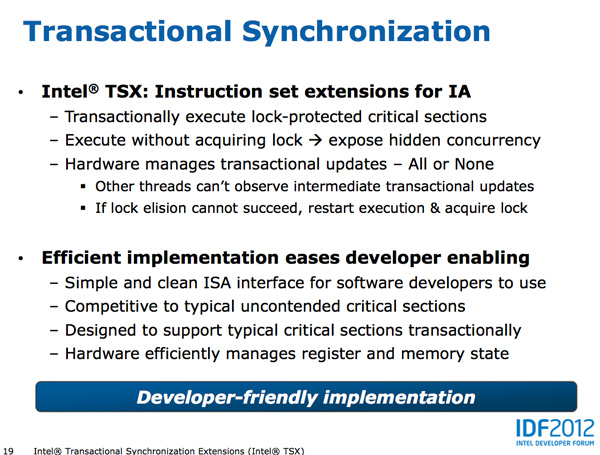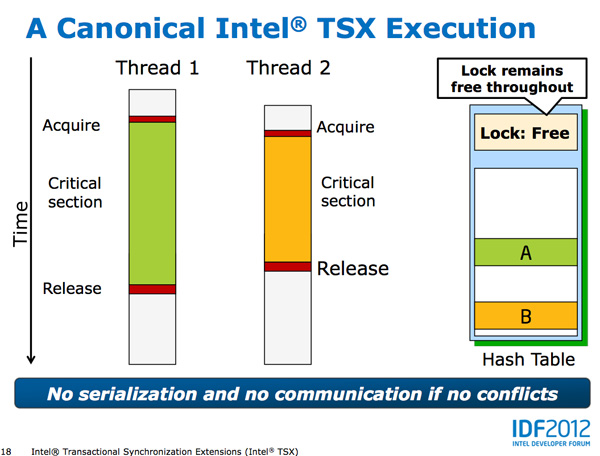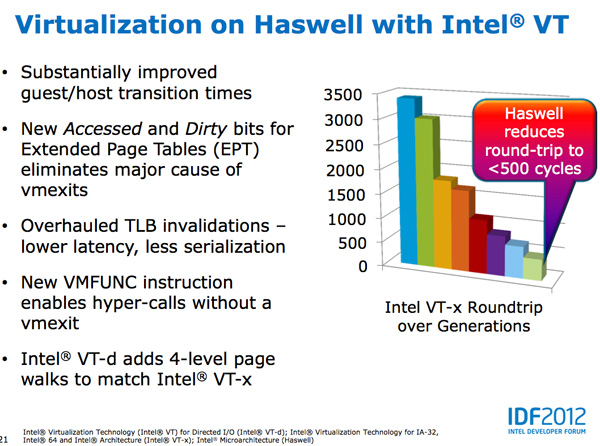Intel's Haswell Architecture Analyzed: Building a New PC and a New Intel
by Anand Lal Shimpi on October 5, 2012 2:45 AM ESTTSX
Johan did a great job explaining Haswell's Transactional Synchronization eXtensions (TSX), so I won't go into as much depth here. The basic premise is simple, although the implementation is quite complex.
It's easy to demand well threaded applications from software vendors, but actually implementing code that scales well across unlimited threads isn't easy. Parallelizing truly independent tasks is the low hanging fruit, but it's the tasks that all access the same data structure that can create problems. With multiple cores accessing the same data structure, running independent of one another, there's the risk of two different cores writing to the same part of the same structure. Only one set of data can be right, but dealing with this concurrent access problem can get hairy.
The simplest way to deal with it is simply to lock the entire data structure as soon as one core starts accessing it and only allow that one core write access until it's done. Other cores are given access to the data structure, but serially, not in parallel to avoid any data integrity issues.
This is by far the easiest way to deal with the problem of multiple threads accessing the same data structure, however it also prevents any performance scaling across multiple threads/cores. As focused as Intel is on increasing single threaded performance, a lot of die area goes wasted if applications don't scale well with more cores.
Software developers can instead choose to implement more fine grained locking of data structures, however doing so obviously increases the complexity of their code.
Haswell's TSX instructions allow the developer to shift much of the complexity of managing locks to the CPU. Using the new Hardware Lock Elision and its XAQUIRE/XRELEASE instructions, Haswell developers can mark a section of code for transactional execution. Haswell will then execute the code as if no hardware locks were in place and if it completes without issues the CPU will commit all writes to memory and enjoy the performance benefits. If two or more threads attempt to write to the same area in memory, the process is aborted and code re-executed traditionally with locks. The XAQUIRE/XRELEASE instructions decode to no-ops on earlier architectures so backwards compatibility isn't a problem.
Like most new instructions, it's going to take a while for Haswell's TSX to take off as we'll need to see significant adoption of Haswell platforms as well as developers embracing the new instructions. TSX does stand to show improvements in performance anywhere from client to server performance if implemented however, this is definitely one to watch for and be excited about.
Haswell also continues improvements in virtualization performance, including big decreases to guest/host transition times.














245 Comments
View All Comments
tim851 - Friday, October 5, 2012 - link
This is a perfect demonstration of the power of competition.With AMD struggling badly, Intel was content in pushing Atom. They didn't want to innovate in that sector, they sold 10 year old technology with horribly outdated chipsets. Yes, they were relatively cheap, but I was appalled.
Step in ARM, suddenly becoming a viable competitor. Now Intel moves its fat ass and tries to actually build something worthwhile.
Sadly, free markets are an illusion. Intel should pay dearly for the Atom fiasco, but they won't. Just as they didn't pay for the Pentium 4 debacle. They will come 5 years late to the party, but with all their might, they will crush ARM. ARM will fall behind, they can't keep up with that viscious tick-tock-cycle. Who can?
In 8 years, ARM will have been bought by some company, perhaps Apple. ARM will then no longer be a competitor, it will be just a different architecture, like X86. I don't see Apple having any long-term interest in designing their own hardware, it's way too unsexy. They will just cross-licence ARM with Intel and in 10 years time, Intel will rule supremely again.
UpSpin - Friday, October 5, 2012 - link
You forget that Intel vs. ARM is something bigger than AMD vs. Intel.Behind ARM stand Qualcomm, Samsung, Apple, ...
All new software is written for ARM, not Intel (x86) any longer. Microsoft releases a rewritten ARM Windows RT with a rewritten Office for ARM. Android runs on ARM and everyone supports the ARM version, while only Intel has to keep it compatible with x86.
Haswell will get released, when exactly? In a year, ARM A15 in maybe two months. Haswell has nice power savings, but it's still a Ultrabook design. The current Atom SoCs are much worse than current A9/Krait SoCs. Intel heavily optimized the software to make it look not that bad (excellent Sunspider results), but they are.
If Windows 8 is a success, Intel can be lucky. If it's not, what many expect, Intel has a real problem.
Intel is a single company building and developing their CPU/SoC. ARM SoCs get build and developed by a magnitude of companies.
If Apple can design their own ARM based SoC which has the same performance as a Haswell CPU (which is easy in the GPU area (the iPad has a faster GPU than the Intel CPUs most probably already, and with A15 and Apples A6 it's possible to get as fast with the CPU, too), they will be able to move Mac OS to ARM. This allows them to build a very very power efficient, lightweight, silent MacBook. They can port apps from iOS to MacOS and vice versa. Because they designed their SoC in-house, they don't have to fear competition the near term.
Apple always wants a monopoly, so it doesn't make sense for them to cross-license anything.
tuxRoller - Friday, October 5, 2012 - link
Unless your app is doing some serious math you can get by with just using a cross platform key chain.Frankly, the hard part is targeting the different apis that are, currently, predominating on each arch. However, assuming those don't change , and the form factor doesn't either, your new app should just be a compile away.
Kidster3001 - Monday, October 15, 2012 - link
Current ATOM SOC's are not "much worse" than A9/Krait. Most CPU benchmarks running in native code will favor the Intel SoC. It's the addition of Android/Dalvik that leans the favor back to ARM. Android has been on ARM for a lot longer and is more optimized for ARM code. Android needs to be tweaked more yet to run optimally on x86.Kidster3001 - Monday, October 15, 2012 - link
" with A15 and Apples A6 it's possible to get as fast with the CPU, too"say what? A15 and A6 are a full order of magnitude slower than Haswell. omg
Dalamar6 - Sunday, May 12, 2013 - link
Nearly all of the software on Android is junk.Apple blocks everything at a whim and gives no control.
I don't know about Windows RT, but I suspect it will suffer the same manner of crap programs Android does if it's not already.
Even if people are more focused on developing for ARM, the ARM OSes are still way behind in program availability(especially quality). And it's downright sad seeing people charging money for simple, poorly coded programs that can't even compare to existing open source x86 software.
jacobdrj - Friday, October 5, 2012 - link
I agree competition is good/great. However, how you categorize Atom is just not true! Atom filled a very real niche. Cheap mobile computing. Not powerful, but x86 and fast enough to do basic tasks. I loved my Atom netbook and used it until it bit the dust last week. Would I have liked more power? Sure, but not at the expense of (at the time) battery life. Besides, once I maxed it out by putting in a SSD and 2 GB RAM, my netbook often outpaced many peoples' newer more powerful Core based laptops for basic tasks like word processing and web browsing.Just because power users were unhappy does not mean Atom was a 'fiasco'. Those old chipsets allowed Atom netbooks to regularly sell, fully functional, for under $200, a price point that Tablets of similar capability are only just starting to hit almost 4 years later...
Don't bash Atom just because you don't fit into it's niche and don't blame Intel for HP trying to oversell Atom to the wrong customers...
Peanutsrevenge - Friday, October 5, 2012 - link
If competition is 'good/great' what does that make cooperation?Imagine the possibility of Intel and AMD working together along with Qualcomm, Imagination etc.....
Zeitgeist Movement.
Kidster3001 - Monday, October 15, 2012 - link
Intel is not going this way because "ARM stepped in". Intel is going this way because it decided to go play in ARMs playground.krumme - Friday, October 5, 2012 - link
My Samsung 9 series x3c (ivy bridge), have a usage looking on this page with wifi at bt on ranging from 4.9W to 9.9W from lowest to higest screen brightness, with a normal usage of screen of 7.2W with good brightness (using samsung own measuring tool).So screen is by far the most important component on a modern machine. In the complete ecosystem i wonder if it matter how efficient Haswell is. The benefit of 10W tdp for say the same performance is nice, but does it really matter for the market effect. And the idle power is already plenty low.
I doubt Haswell will have an significant impact - as nice as it is. This is just to late and way to expensive for the mass market. Those days are over.
At the time it hits market dirt cheap TSMC 28nm A15 and bobcat successor hits the market for next to nothing, and will give 99% of the consumers the same benefits.